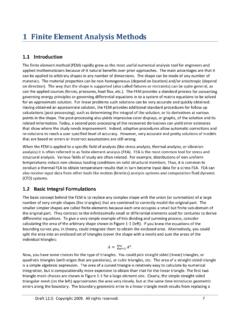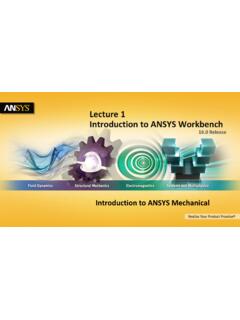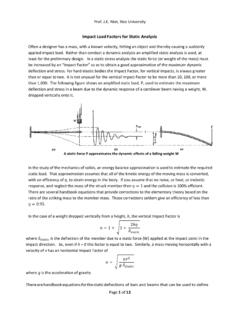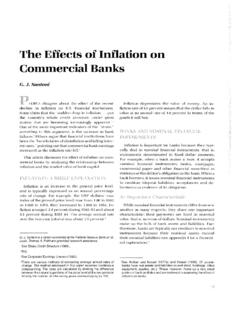Transcription of curved beam strength - Rice University
1 Bending of curved Beams strength of Materials ApproachNMVr cross-section must be symmetric but does not have to be rectangularassume plane sections remain plane and just rotate about the neutral axis, as for a straight beam, and that the only significant stress is the hoop stress NMcentroidneutral axisnRRrR = radius to centroidRn= radius to neutral axisr = radius to general fiber in the beamN, M = normal force and bending momentcomputed from centroid ABABPPnRr ()1nnRrRlelrr === = Let = rotation of thecross-sectionReference: Advanced Mechanics of Materials.
2 Boresi, Schmidt, andSidebottomFrom Hooke s law1nREeEr == Then the normal force is given by()nAAAnmdANdAER dArERA A == = wheremAdAAr= has the dimensions of a lengthSimilarly, for the moment()()()1 AnAnnAA AAnmMRrdARERrdArdAER RR dA R dArdArER RA A = = = + = ()()nmnmMER RA ANE RA A = = from (1)(1)(2)nmMERRAA = from (2)()nmmmNERAEAMAEARAA = = so solving for E ()mmMANEARAAA = 1nnREeErEREr == = Recall, the stress is given byso using expressions for ,nERE we obtain the hoop stress in the form()()mmMArANAAr RAA =+ axialstressbendingstressnrR=setting the total stress = 0 gives0N ()
3 0mmAMrAMNARA ==+ 0N=setting the bending stress = 0 and givesnmARA=which in general is not at the centroidlocation of theneutral axisFor composite areasA1A21R2 RimmiiiiAAAARARA=== radii to centroidsareasExamplePP100 mm30 mmFor a square 50x50 mm cross-section, find the maximum tensile and compressive stress if P = kN and plot the total stress across the cross-sectionP = 9500 NMN155 mmacb()2lnmAbc aacRcAba= += = a= 30 mmb= 50 mmc= 80 mmso we have()()250 5025008050 30552mAmmAmmRmm== == +== tensile stress is at r = 30 mm()()()( ) ()( )()()()( )155 9500 250030 3055 rANAArRA AMPa =+ =+ =max compressive stress is at r = 80 mm()()()( ) ()( )( )()()( )155 9500 250080 8055 rANAArRA AMPa =+ =+ = >> r= linspace(30, 80, 100);>> stress = + 589*(2500 - *r).
4 /( *r);>> plot(r, stress)3035404550556065707580-60-40-2002 0406080100120radius, rstressComparison with Airy Stress Function ResultsConsider a rectangular beam under pure momentabrMMthickness = tRhNote: ()()()()/1/2/ 12/ 1/2/ 1baRhbaRhbaRh+= += y22224lnlnln1 Mab bb ra rbNtaraaaab aa = + + From Airy Stress Function222214lnbbbNaaa = strength Approach()()ln/2mbAtaAtb aRab = = =+()()()()()()2lnln221ln1211lnmmMA rAAr RAAbMba raabbtrbabaabrbMaaarbbbbtaaaaaa = =+ = + If we had used the ordinary straight beam formulainstead()()
5 33221126211abMrMyItb arbaaMtaba + == + = minus on M since it is opposite to what we had beforeComparison of the ratio of the max bending beam formula My/IStrength/elasticityCurved beamformulaR/hRhyCompare bending stress distributions at the smallest R/h stresssolid curve Airy stress function (elasticity)dashed blue curved strength formuladashed red Straight beam formulaR/h = (b/a = )% ;Rhvals = [ ]; % R/h ratios to considerfor Rh = Rhvalsba = (1+2*Rh)/(2*Rh -1); %corresponding b/a valuesra= linspace(1, ba, 100); % r/a valuesN=(ba^2-1)^2 -4*ba^2*(log(ba))^2;% Airy function flexure stress expressionpa =4*(-( ).)
6 ^2.*log(ba)+(ba)^2.*log( ) - log(ra) +(ba)^2 -1)./N; % curved beam strength expression for flexure stressps = 2*((ba-1)-ra.*log(ba))./(ra.*(ba-1).*(2. *(ba-1) -(ba+1).*log(ba)));% Straight beam flexure formula My/Ipb = 6*(2*ra-(ba+1))./((ba-1)^3);%obtain ratio of max stresses curved beam strength formula/Airyratio1(m) = max(abs(ps))/max(abs(pa));%obtain ratio of max stresses: Straight beam strength formula/Airyratio2(m) = max(abs(pb))/max(abs(pa));m=m+1;end% Now plot stress distributions for smallest R/h valueRh= = (1+2*Rh)/(2*Rh -1); %corresponding b/a valuesra= linspace(1, ba, 100);N=(ba^2-1)^2 -4*ba^2*(log(ba))^2;pa =4*(-( ).
7 ^2.*log(ba)+(ba)^2.*log( ) - log(ra) +(ba)^2 -1)./N; ps = 2*((ba-1)-ra.*log(ba))./(ra.*(ba-1).*(2. *(ba-1) -(ba+1).*log(ba)));pb = 6*(2*ra-(ba+1))./((ba-1)^3);plot(ra, pa)hold onplot(ra, ps, '--b')plot(ra, pb, '--r')xlabel('r/a')ylabel( 'normalized stress')hold offComparison with Bickford s expression (pure bending)()211/kMMyAkyIkR = +=Rrcentroidyy First note that0 AydA= Here, y is distance from the centroidso()2211/101/1/1/AAAyyRIydAy dAdAIyRyR RyRR+=+=+=+++ 1221/1/AAydAIyRydAIyR=+=+ 21 IIR= Rry = orryR=+mAAdAdARARRryR==+ ()()1 AAAAmyRydAAdAdAdARyRyRyRIRAR+===++++=+ 1/IRThus,()12/mRRA AI I R = =()
8 211/kMMyAkyIkR = +=Now, start with Bickford s expression()()()()()()()()()()()()222223 2222222222222232221//yRMARy R IyRI yARMyRARIyRI yRARARMyRARIyRARIIARRMARIy R IIARRMyRIARIAyRI AR RMyRAI R = + + ++= + +++= ++ += + += + + + =+ same terms added in and subtracted out()()()23222//AyRI AR RMyRAI R + + =+ but 22/mRAAIR =so()232/mAIARR=+and we find yRr+=()mmArArRA AA = which agrees with our previous expressionfrom Bickford s expression()211/kMMyAkyIkR = +=it is easy to see, as , R 0k and2221/AAydAIydA IyR= =+ and we recover the straight beam flexure expressionMyI =












